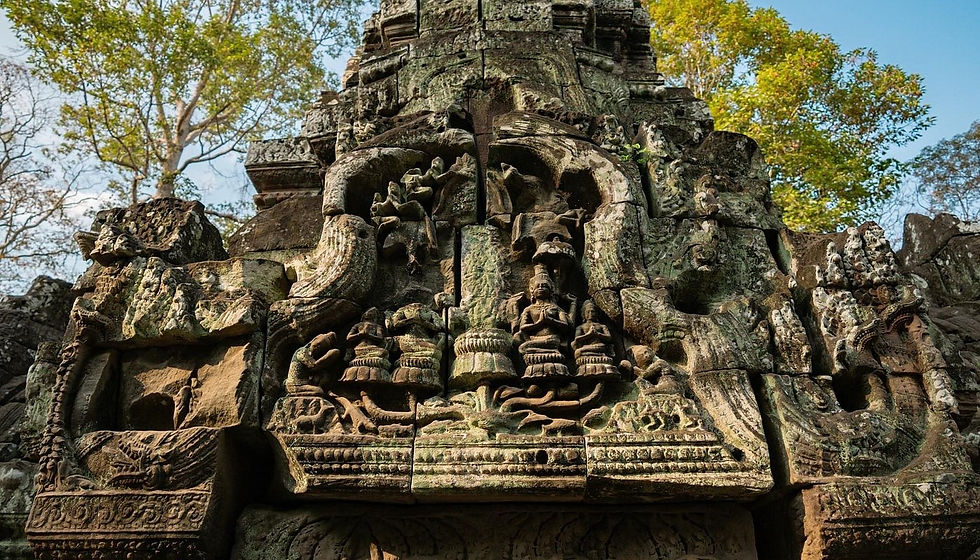Ta Som Temple - Echoes of Stone
- Shannon
- May 30
- 3 min read
Updated: Jun 26
Tucked quietly in the northern stretches of the Angkor Archaeological Park lies Ta Som, a temple often overshadowed by its grander neighbours but brimming with enigmatic charm. Built in the late 12th century under the reign of King Jayavarman VII, one of the most prolific temple builders in Cambodian history, Ta Som is a smaller-scale reflection of the Bayon style, marked by smiling stone faces and Buddhist symbolism. Historians believe it was dedicated to either Jayavarman’s father or possibly a revered teacher or spiritual advisor, underscoring the King’s deep reverence for familial and spiritual bonds.

Although less expansive than sister temples like Ta Prohm and Preah Khan, Ta Som captivates with an almost dreamlike decay. The most iconic feature is its eastern gate, where the stone face of Avalokiteshvara, the bodhisattva of compassion, peers out from a mass of sacred fig tree roots. Over time, these roots have wrapped themselves tightly around the gopura, creating a living sculpture that blurs the line between architecture and nature. This imagery evokes comparisons to the more photographed strangler figs at Ta Prohm but with far fewer crowds.
Architecturally, Ta Som follows the typical layout of Jayavarman VII's spiritual sanctuaries, centered around a single towered shrine and enclosed by two concentric laterite walls. Gopuras mark the four cardinal directions, aligning the site with the sacred mandala layout central to Khmer cosmology. The design is modest and functional, suggesting it may have been one of Jayavarman’s later projects, constructed during a period when his temple building campaign was driven by both spiritual urgency and political ambition. Unlike other temples teeming with detailed bas-reliefs, Ta Som’s sparse carvings and simplified iconography imply a rapid construction, possibly to establish spiritual markers across key travel routes.
Despite its modesty, the temple is steeped in legend. Local guides speak of the “Watcher in the Roots,” a spectral figure said to dwell within the gnarled fig tree that crowns the eastern gate. It is rumoured that if one stares long enough into the tree’s shadowy hollows, they may see eyes looking back. Another myth centres on a mossy corridor near the inner sanctum, dubbed “the bleeding wall.” During full moons, streaks of deep red reportedly appear along the stones. Scientists attribute this to a rare strain of algae reacting to moisture and moonlight but oral traditions insist it's the trace of ancient rituals, possibly blood sacrifices, that were absorbed into the temple itself.

Location : Angkor Archaeological Park, Ta Som Temple, Siem Reap Province, Kingdom of Cambodia
How to get there : Ta Som is located about 15 minutes northeast of Angkor Wat and is part of the 'Grand Circuit' tour. It is best visited early in the morning, when the majority of other tourists are at Angkor Wat. A tuk tuk driver can get you around for about $50 USD per day.
Attraction Info : Admission is included with the Angkor temple pass. Entrance fees are structured to accommodate various itineraries. A 1-day pass is $37USD, a 3-day pass is $62USD and a 7-day pass at $72USD. Tickets can be purchased at the official Angkor Ticket Office or online. Generally 3 days is sufficient time to explore the area. The grounds are open between 7:30am - 5:30pm. Given its vast size, it is sensible to set aside at least an hour to properly explore this temple.
ប្រាសាទតាសោម
Official Website : https://www.angkorenterprise.gov.kh/
Thanks for reading about the Ta Som Temple - Echoes of Stone. Check out more destinations here!


















